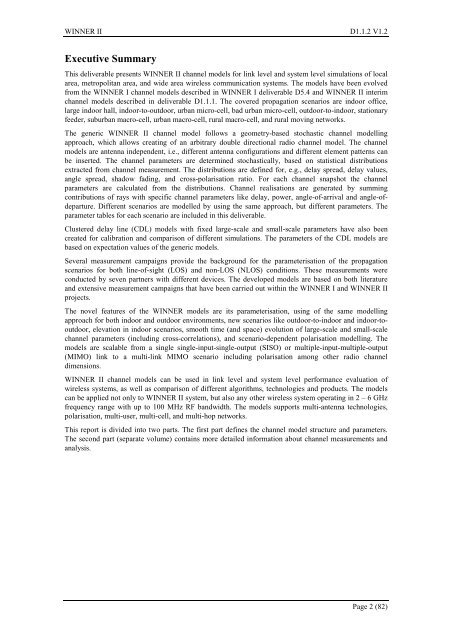WINNER II pdf - Final Report - Cept
WINNER II pdf - Final Report - Cept
WINNER II pdf - Final Report - Cept
Create successful ePaper yourself
Turn your PDF publications into a flip-book with our unique Google optimized e-Paper software.
<strong>WINNER</strong> <strong>II</strong> D1.1.2 V1.2<br />
Executive Summary<br />
This deliverable presents <strong>WINNER</strong> <strong>II</strong> channel models for link level and system level simulations of local<br />
area, metropolitan area, and wide area wireless communication systems. The models have been evolved<br />
from the <strong>WINNER</strong> I channel models described in <strong>WINNER</strong> I deliverable D5.4 and <strong>WINNER</strong> <strong>II</strong> interim<br />
channel models described in deliverable D1.1.1. The covered propagation scenarios are indoor office,<br />
large indoor hall, indoor-to-outdoor, urban micro-cell, bad urban micro-cell, outdoor-to-indoor, stationary<br />
feeder, suburban macro-cell, urban macro-cell, rural macro-cell, and rural moving networks.<br />
The generic <strong>WINNER</strong> <strong>II</strong> channel model follows a geometry-based stochastic channel modelling<br />
approach, which allows creating of an arbitrary double directional radio channel model. The channel<br />
models are antenna independent, i.e., different antenna configurations and different element patterns can<br />
be inserted. The channel parameters are determined stochastically, based on statistical distributions<br />
extracted from channel measurement. The distributions are defined for, e.g., delay spread, delay values,<br />
angle spread, shadow fading, and cross-polarisation ratio. For each channel snapshot the channel<br />
parameters are calculated from the distributions. Channel realisations are generated by summing<br />
contributions of rays with specific channel parameters like delay, power, angle-of-arrival and angle-ofdeparture.<br />
Different scenarios are modelled by using the same approach, but different parameters. The<br />
parameter tables for each scenario are included in this deliverable.<br />
Clustered delay line (CDL) models with fixed large-scale and small-scale parameters have also been<br />
created for calibration and comparison of different simulations. The parameters of the CDL models are<br />
based on expectation values of the generic models.<br />
Several measurement campaigns provide the background for the parameterisation of the propagation<br />
scenarios for both line-of-sight (LOS) and non-LOS (NLOS) conditions. These measurements were<br />
conducted by seven partners with different devices. The developed models are based on both literature<br />
and extensive measurement campaigns that have been carried out within the <strong>WINNER</strong> I and <strong>WINNER</strong> <strong>II</strong><br />
projects.<br />
The novel features of the <strong>WINNER</strong> models are its parameterisation, using of the same modelling<br />
approach for both indoor and outdoor environments, new scenarios like outdoor-to-indoor and indoor-tooutdoor,<br />
elevation in indoor scenarios, smooth time (and space) evolution of large-scale and small-scale<br />
channel parameters (including cross-correlations), and scenario-dependent polarisation modelling. The<br />
models are scalable from a single single-input-single-output (SISO) or multiple-input-multiple-output<br />
(MIMO) link to a multi-link MIMO scenario including polarisation among other radio channel<br />
dimensions.<br />
<strong>WINNER</strong> <strong>II</strong> channel models can be used in link level and system level performance evaluation of<br />
wireless systems, as well as comparison of different algorithms, technologies and products. The models<br />
can be applied not only to <strong>WINNER</strong> <strong>II</strong> system, but also any other wireless system operating in 2 – 6 GHz<br />
frequency range with up to 100 MHz RF bandwidth. The models supports multi-antenna technologies,<br />
polarisation, multi-user, multi-cell, and multi-hop networks.<br />
This report is divided into two parts. The first part defines the channel model structure and parameters.<br />
The second part (separate volume) contains more detailed information about channel measurements and<br />
analysis.<br />
Page 2 (82)
















